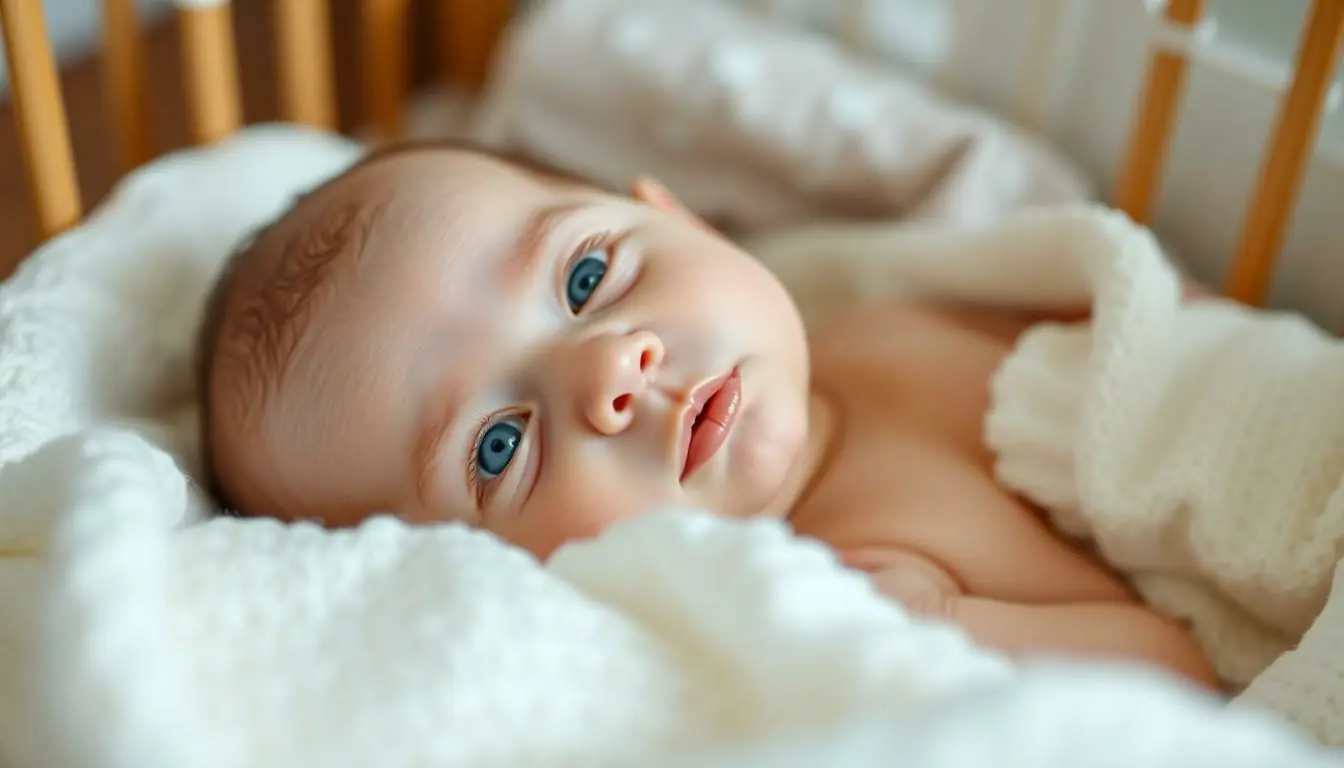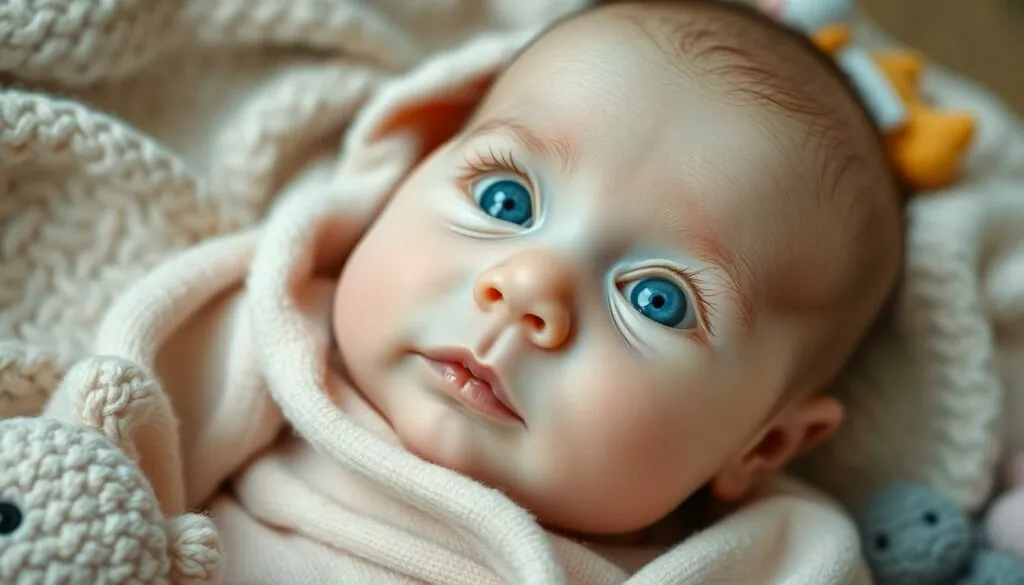Table of Contents
ToggleWhen a tiny bundle of joy enters the world, one of the first things people notice is those adorable little eyes. But here’s the kicker: do all newborns really have blue eyes? It’s a question that’s sparked curiosity and debate, leaving parents and onlookers scratching their heads.
As it turns out, the answer is a bit more complex than a simple yes or no. While many newborns start with striking blue peepers, the color can change faster than a toddler’s mood. Understanding the science behind eye color can be as fascinating as watching a baby giggle for the first time. So, let’s dive into the colorful world of newborn eye hues and discover what’s really going on behind those innocent gazes.
Understanding Newborn Eye Color
Newborn eye color is a fascinating subject steeped in genetics and various influencing factors. While many babies appear to have blue eyes at birth, this color can evolve significantly during the first year.
The Genetics of Eye Color
Eye color originates from genetic combinations inherited from parents. Two primary pigments determine this trait: eumelanin, resulting in brown hues, and pheomelanin, leading to lighter shades like blue or green. Specific genes interact to influence the amount and distribution of these pigments. Variations in genes such as OCA2 and HERC2 play a critical role in determining the final eye color. Since a majority of Caucasian babies exhibit blue eyes at birth, this commonality raises curiosity regarding genetic patterns.
Factors Influencing Eye Color in Newborns
Multiple factors affect the final eye color of newborns beyond genetics. Age stands out as a primary influence; many infants experience changes in eye color during the first few months. Environmental exposure can also play a role, as lighting conditions may alter perceived color. Additionally, melanin production ramps up as a child grows, changing their eye appearance over time. Nutritional factors such as vitamin D and general health can contribute to eye pigmentation. These elements combined ensure that a baby’s eye color journey is unique and may not settle until several months after birth.
The Common Myth: Do All Newborns Have Blue Eyes?

Many people believe that all newborns start with blue eyes. While it’s true that a significant number of infants possess this color at birth, it’s not universal.
The Science Behind Eye Color Change
Eye color results from complex genetics. At birth, a newborn’s melanin levels often remain low, leading to blue or gray eyes. As the baby grows, melanin production may increase, altering the eye color. By the age of one, many children display their permanent eye color, shaped by the influence of genes like OCA2 and HERC2. These genes dictate melanin levels, determining whether the eyes remain blue or shift to shades of brown, green, or hazel. Environmental factors and nutrition may further affect color changes, highlighting that every baby’s journey is unique.
Cultural Perceptions of Eye Color
Cultural views on eye color significantly vary. In some societies, blue eyes confer a sense of beauty or rarity, while darker eyes often symbolize strength and wisdom. Advertisements frequently reinforce these associations, promoting specific eye colors as desirable. Variations in perception span across cultures, shaping preferences for eye colors uniquely. Notably, medical communities focus on the genetic basis for eye color rather than cultural significance, emphasizing that eye color simply reflects an individual’s genetic makeup. This diversity enhances the beauty of human traits, resulting in an intriguing interplay between biology and culture.
Variations in Newborn Eye Colors
Newborns exhibit a range of eye colors, which can change dramatically during their first year. At birth, many infants display shades of blue or gray due to low melanin levels.
Common Eye Colors in Newborns
Commonly, newborns present blue, gray, or light hazel eyes. Around 75% of infants exhibit blue eyes initially. As melanin production increases, eye colors often shift toward brown, green, or deeper hazel tones. An estimated 10% of newborns are born with brown eyes, which is attributed to higher melanin levels from birth. Over the first year, many babies’ eye colors stabilize, reflecting their genetic backgrounds.
Rare Eye Color Occurrences
Rare eye colors in newborns include green, amber, and grayish-brown. Less than 2% of infants showcase green eyes at birth, making them particularly unique. Some babies may even have a combination of colors, known as heterochromia, a rare occurrence affecting approximately 1 in 1,000 individuals. These less common shades arise from genetic variations and environmental factors, further contributing to the diverse spectrum of newborn eye colors.
Factors Affecting Eye Color Development
Eye color development in newborns depends on several factors, primarily genetics and environmental influences. Understanding these aspects reveals the complexity behind why a baby’s eyes may change over time.
Melanin Production in Infants
Melanin production significantly impacts eye color. At birth, most infants have low melanin levels, leading to blue or gray eyes. As they grow, increased melanin production can change their eye color to shades such as brown, green, or hazel. Over the first year, many babies experience this transformation as their bodies produce more melanin in response to genetic signals. The genes OCA2 and HERC2 play crucial roles in this process, affecting how melanin is distributed in the iris. Ultimately, by around age one, a baby’s eye color may stabilize, reflecting their inherited traits.
Environmental Influences
Environmental factors also influence eye color development. Exposure to sunlight can stimulate melanin production, which may affect the final color of a child’s eyes. For example, infants raised in sunnier climates often develop darker eyes compared to those in less sunny areas. Nutritional elements, particularly diet richness in vitamins and minerals, can impact overall health and pigmentation. While genetics remains the primary determinant of eye color, environmental elements can subtly shape the final result by promoting melanin activity. Thus, the interplay between genetics and environment creates a unique eye color journey for each child.
Newborns often start their journey with blue eyes due to low melanin levels. However this initial color can change dramatically as melanin production increases during the first year. The interplay of genetics and environmental factors shapes each child’s unique eye color experience.
While many parents may hope for a specific eye color the reality is that this trait is influenced by a variety of elements beyond simple genetics. Understanding this process helps to appreciate the beauty and diversity of eye colors that emerge as children grow. Ultimately the eye color journey is a fascinating aspect of human development that reflects both individual genetics and broader cultural perceptions.







